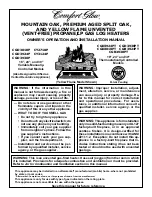
Problem solving
RTG 199 ME – 6 720 811 615 (2015/04)
45
No rotational speed sensor signal from
primary fan.
1. Disconnect power supply cord and check wire connections on back side of fan and
the two connectors on the control board.
2. Check supply voltage. It must be 120VAC and properly grounded.
3. Possible defective component in fan or defective control unit call manufacturer for
further instructions.
(Flashing)
Water flow signal over specified
maximum value.
Water flow > 10 gallon/min.
(Status message).
1. Disconnect power supply cord and check wire connections on water valve and the
two connectors on the control board.
2. Excessive water pressure and flow. Ensure water pressure is less than 150psi and
flow rate is below 10 gallons per minute.
Over-temperature detected by outlet
temperature sensor.
Temperature > 185°F
1. In areas where water has a high mineral content, periodic descaling may be
necessary. See chapter7.3, page 37 for directions.
2. Check wire connections at outlet temperature sensor.
3. Check sensor (ref. page 47, chapter 10).
Inlet temperature sensor fault.
1. Check wire connections at inlet temperature sensor.
2. Sensor may trip if water temperature drops below 36°F (2°C). Protect heater
from freezing conditions as any damage due to freezing conditions is not covered
under warranty.
3. Check sensor (ref. page 48, chapter 11).
Backflow temperature sensor over
309°F.
The appliance will close the burner and
lock (non-volatile).
1. Check inlet/outlet vent pipes.
2. Check if secondary fan connections are disconnected.
3. Check if venting specifications are met. Long vent lengths, venting with more than
three elbows, blocked vent or combination venting may cause this failure. See
chapter 4.3, page 11.
4. Call manufacturer for further instructions.
Overheat sensor (ECO) open circuit
(resets when cooler temperatures are
detected 220°F/104 °C).
1. Disconnect power supply cord and check wire connections on the overheat sensor
(fig. 70, #11, page 50) and the two connectors on the control board.
2. Check white wire connections at the overheat sensor. Clean terminals with an
eraser. If badly corroded, replace sensor and wire harness.
3. Check that venting specifications are met, see chapter 4.3, page 11. Long vent
lengths, venting with more than three elbows, blocked vent or combination
venting may cause this failure.
4. In areas where water has a high mineral content, periodic descaling may
necessary, see chapter 7.3, page 37.
5. Unplug power supply cord to the water heater. Open a hot water tap for several
minutes to allow cold water to pass through heat exchanger. Close hot water tap
and disconnect lead wires to overheat sensor. Using a multimeter, check
continuity through overheat sensor contacts. Replace sensor if open.
Display
Cause
Solution
Table 41
* By installer or service technician only.
Summary of Contents for RTG 199 MEN
Page 55: ...RTG 199 ME 6 720 811 615 2015 04 55 Notes...
Page 56: ......












































